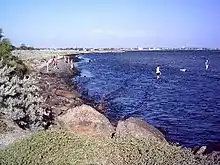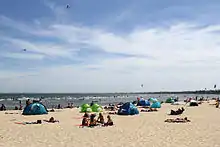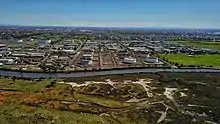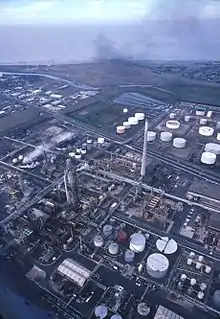Altona, Victoria
Altona is a suburb of Melbourne, Victoria, Australia, situated 13 km south-west of Melbourne's Central Business District,[2][3][4] and located within the City of Hobsons Bay local government area. Altona recorded a population of 10,762 at the 2016 census.
| Altona Melbourne, Victoria | |||||||||||||||
|---|---|---|---|---|---|---|---|---|---|---|---|---|---|---|---|
 Main street of Altona | |||||||||||||||
 Altona | |||||||||||||||
| Coordinates | 37.868°S 144.830°E | ||||||||||||||
| Population | 10,762 (2016 census)[1] | ||||||||||||||
| • Density | 636.8/km2 (1,649/sq mi) | ||||||||||||||
| Postcode(s) | 3018 | ||||||||||||||
| Area | 16.9 km2 (6.5 sq mi) | ||||||||||||||
| Location | 13 km (8 mi) from Melbourne | ||||||||||||||
| LGA(s) | City of Hobsons Bay | ||||||||||||||
| State electorate(s) | Altona | ||||||||||||||
| Federal Division(s) | Gellibrand | ||||||||||||||
| |||||||||||||||
Altona is a large suburb consisting of low density residential in the south-eastern half and mixed industry in the north-western half. A feature of the suburb is Altona Beach, which is one of only two swimming beaches in the western suburbs (the other being Williamstown Beach).
Altona takes its name from the then independent German city of Altona[5] which is today a borough of Hamburg.
History


Prior to arrival of Europeans, the Altona area was home to Kurung-Jang-Balluk Aboriginal people, of the Woiwurrung clan.
Altona was first permanently settled in 1842, with the construction of The Homestead by Alfred Langhorne. The name 'Altona' first appeared on maps in 1861.[5] It was named by Frederick Taegtow, a German who hailed from Altona, then a town just outside of Hamburg.[6] Taegtow believed that coal was to be found in the area, and in 1881 he formed the Williamstown (Taegtow) Prospecting Company.[5] From 1886, housing in the Altona and Merton Street estates was sold, and by 1901 the Victorian Government owned an explosives reserve in the west of Altona.
On 20 February 1911, J. J. Hammond flew the first cross country flight between towns in Australia from Altona Bay to Geelong in Victoria, and on 23 February, also at Altona Bay, he undertook the first powered passenger flight in Australia.[7]
Coal mining formed the basis of the local economy from 1908 to 1919. However, this was brought to an end in 1930 when open cut mining was developed in the Latrobe Valley.
By 1918 the population was sufficient to justify a Post Office which opened on 14 January 1918.[8]
Following the Second World War Altona received a large influx of immigrants, primarily from the Mediterranean, Central Europe and a smaller number from the Middle East.
From 1862 Altona was a town in the Shire of Werribee, but in 1957, the Altona Riding of the Shire, which included Altona itself as well as Altona North and Altona Meadows, was severed, and became the City of Altona in 1968.[9] This was merged into the City of Hobsons Bay in June 1994 under local government amalgamations undertaken by the Kennett government.
Politics

On 24 June 2010, Altona became home to Australia's first female prime minister, Julia Gillard, a then resident of Altona. Gillard was voted in by the governing Australian Labor Party to replace Kevin Rudd as its leader, making her Australia's 27th Prime Minister.[10]
Population
According to the 2016 Census, there were 10,762 people in Altona, with 64.6% of Altona residents born in Australia. The next most common countries of birth were England 4.8%, New Zealand 2.3%, Malta 2.1%, India 1.7% and Italy 1.6%. 73.3% of residents only spoke English at home. Other languages spoken at home included Italian 2.3%, Maltese 2.2%, Mandarin 1.7%, Vietnamese 1.3% and Greek 1.3%. The most common responses for religion in were No Religion 33.2%, Catholic 30.5% and Anglican 8.9%.[1]
Parks and gardens


Altona has many significant parks and gardens, including some important environmental conservation areas and wetlands along the shores of Port Phillip. These are also used by visitors and residents recreationally and include a long promenade along the bay. Notable areas include:
Education
Altona has four primary schools consisting of Altona Primary School, Seaholme Primary School, Altona College (a merger between the former Altona Secondary College and Altona West Primary School) and St. Marys Catholic Primary School. The secondary schools include Mount St. Joseph Girls' College and Altona College (Altona Secondary College changed its name in 2007).
Altona has a library branch, which contains the Environmental Resources Centre. This centre provides the community with access to media related to environmental initiatives in Hobsons Bay, including Industry Environment Improvement Plans from local industry.
Culture
The Altona Beach Festival is a free event held annually at the Logan Reserve precinct, (located on the Esplanade and includes the Logan Reserve parklands, part of Pier Street and the Esplanade), to promote and celebrate Hobsons Bay and the western suburbs. The festival includes a twilight street parade, beach market, double-decker bus tour, professional entertainers, RAAF fly-overs and fireworks off the Altona Pier.
The Altona Beach Festival was previously known as the Bayside Festival and also Operation Recreation, and some residents still refer to it by one of these names. The 30th anniversary of the festival was held in 2007. It enjoyed a brief period of heightened prominence in 2002 when it was featured on the Channel 9 travel program Postcards in a segment hosted by Geoff Cox. Scouts Australia is a major feature of the parade and the many community activities that take place close to the beach front.
The Altona City Theatre is a production company based in the Altona Civic Theatre, producing two major musicals and a smaller pantomime annually. The pantomime coincides with the Bayside Festival and was originally intended as an outlet for young directors.
Scouts Australia has two groups in Altona. The 1st Altona Scout Group runs from the Scout Hall. The 4th Altona Scout Group are located at the Pines, an old camp owned by the City of Hobsons Bay.
Sport

Altona is home to many sporting clubs including Australian rules football, soccer, hockey, basketball, cricket and lacrosse. Melbourne Ballpark is a baseball complex in the west of Altona.
Altona is represented by many sporting teams, including the Altona Magic soccer team which competes in the Victorian State League Division 1, the third tier in Australia behind the A-League and the Victorian Premier League. Altona City SC plays in Victorian State League Division 2 N/W.
Altona has an Australian Rules football team competing in the Western Region Football League.[11]
The Altona Roosters complete in the Victorian Rugby League, and play home games at Loft Reserve, in neighbouring Newport.
Golfers play at the course of the Kooringal Golf Club on Wilga Avenue.[12]
The area of Altona beach directly west of Altona Pier is one of Melbourne's most popular spots for kitesurfing.
Transport
Trains
Altona has two railway stations, railway stations, Altona and Westona, both of which are on the Altona Loop. This is one of the two lines that runs between Newport and Laverton stations (the other being a Newport direct Express to Laverton track the runs along the former Geelong Railway Line, located along the northern boundary of Altona). Early morning and late night services to Werribee, as well as all weekend services, run via the Altona loop. At other times, the Altona loop is serviced by Laverton services.
Bus
Route 411: Laverton Station to Footscray (via Altona Meadows and Altona)
Route 412: Laverton Station to Footscray (via Altona Meadows and Altona)
Route 415: Laverton Station to Williamstown (via Altona)
Route 903: Altona to Mordialloc (SMARTBUS Service)
Route 944: City to Point Cook (Night Bus Service)
Other
The Hobsons Bay Coastal Trail, a shared path for cyclists and pedestrians, follows the coast through Altona. It links up with a path around Cherry Lake. Most major roads have on-road cycleways.
Industry


Local industry includes petrochemical storage, manufacturing and distribution. The Altona Petrochemical Complex was established in the early 1960s, utilising feedstocks from the nearby Altona Refinery, and later the Bass Strait gas fields, to produce a wide range of products for the chemical and plastics industry.[13] The complex grew to become the largest petrochemical installation in the southern hemisphere and included major global chemical companies such as Dow Chemicals, Union Carbide, Hoechst, BF Goodrich and BASF.[14] This was a major environmental concern to residents in the 1970s and 1980s. Strict environmental controls and local projects involving industry, government and environmental groups have reduced these concerns, cleaning up coastal areas that were once neglected.[15]
The Toyota Australia Altona Plant is located in the neighbouring suburb of Altona North. The plant built Camrys and Aurions, 80% of which were for the world market. The plant was closed in 2017.
Notable residents
- Julia Gillard – was an Altona resident while serving as Australia's 27th Prime Minister
- Adrian Tantari - Queensland politician, born in Altona[16]
See also
- Altona Beach
- Altona Meadows
- Altona North
- City of Altona – Altona was previously within this former local government area.
- Seaholme
References
- Australian Bureau of Statistics (27 June 2017). "Altona (State Suburb)". 2016 Census QuickStats. Retrieved 21 July 2017.

- "Oil Painting". The Age. Melbourne. 7 January 2006. Archived from the original on 12 May 2009. Retrieved 5 June 2009.
- "Altona". totaltravel.com. Archived from the original on 27 March 2009. Retrieved 5 June 2009.
- "Altona, Victoria". Australian Places. Monash University. Archived from the original on 25 August 2006. Retrieved 25 July 2013.
- Kennedy, B: Australian Place Names, page 5. ABC Books, 2006
- "Mining". Altona Homestead. Altona Laverton Historical Society Inc. Retrieved 25 February 2018.
- Australian National Aviation Museum. "Aviation in Australia". Australian National Aviation Museum. Archived from the original on 13 September 2007. Retrieved 15 September 2007.
- Premier Postal History. "Post Office List". Retrieved 11 April 2008.
- Victorian Municipal Directory. Brunswick: Arnall & Jackson. 1992. p. 282. Accessed at State Library of Victoria, La Trobe Reading Room.
- "New PM". Archived from the original on 29 June 2010. Retrieved 24 June 2010.
- Full Points Footy. "Altona". Archived from the original on 12 June 2010. Retrieved 15 April 2009.
- Golf Select. "Kooringal". Retrieved 11 May 2009.
- Smith, Ailie (13 April 2000). "Altona Petrochemical Complex (c. 1961 - )". Encyclopaedia of Australian Science. Retrieved 9 July 2017.
- "The petrochemical complex at Altona". Technology in Australia 1788-1988. Australian Science and Technology Heritage Centre. 2000. Retrieved 9 July 2017.
- Harding, Nessie. "THE ALTONA CHEMICAL COMPLEX NEIGHBOURHOOD CONSULTATIVE GROUP" (PDF). Qenos. Retrieved 9 July 2017.
- https://www.frasercoastchronicle.com.au/news/get-to-know-your-candidates-adrian-tantari/3271587/